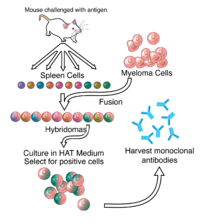
Photo from wikipedia
Aggregates are amongst the most important product‐related impurities to be removed during the downstream processing of antibodies due to their potential immunogenicity. Traditional operations use cation‐exchange resins in bind‐elute mode… Click to show full abstract
Aggregates are amongst the most important product‐related impurities to be removed during the downstream processing of antibodies due to their potential immunogenicity. Traditional operations use cation‐exchange resins in bind‐elute mode for their separation. However, frontal analysis is emerging as an alternative. In this study, a three‐step process development for a membrane adsorber and a resin material is carried out, allowing the comparison between the stationary phases. Based on a screening study, optimal loading conditions are determined, which show that weak binding is favored on the membrane and strong binding on the resin. Transfer of these findings to breakthrough experiments shows that at 99% pool purity the yield is higher for the membrane, while the resin can be loaded twice as high, exceeding yields of 85%. For the investigated antibody and based on a given regeneration protocol, the productivity of the two phases is similar, ranging around 200 g/(L·h). Due to the higher loading, the resin requires about one‐third less buffer than the membrane. Furthermore, the implementation of a wash step after loading allows to further increase yield by about 5%. In comparison to a generic bind‐elute process, productivity and buffer consumption are improved by an order of magnitude.
Journal Title: Biotechnology and Bioengineering
Year Published: 2019
Link to full text (if available)
Share on Social Media: Sign Up to like & get
recommendations!